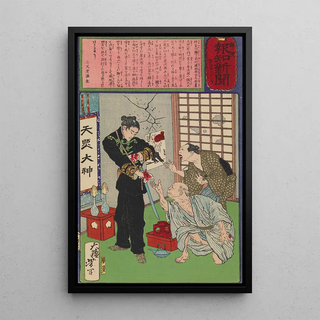Painting Ota Yazaemon and his son Fusajir cut and exchange fingers before the son goes to war - Tsukioka Yoshitoshi | Art print


View from behind

Frame (optional)
Ota Yazaemon and his son Fusajir cut and exchange fingers before the son departs for war: an act of bravery and sacrifice
In this poignant artwork, Tsukioka Yoshitoshi captures a moment of deep emotion and symbolism. The scene depicts Ota Yazaemon and his son Fusajir, united in a ritual of separation before leaving for war. The vivid colors and meticulous details of traditional Japanese clothing contrast with the intensity of the gesture, where the exchanged fingers symbolize an unbreakable bond. The technique of ukiyo-e printmaking, characteristic of Yoshitoshi, brings this scene to life, creating an atmosphere that is both dramatic and touching, where duty and family love meet.
Tsukioka Yoshitoshi: master of the modern Japanese ukiyo-e print
Tsukioka Yoshitoshi, born in 1839, is one of the last great masters of ukiyo-e printmaking, a traditional Japanese art. His work stands out for its innovative approach and sensitivity to the social changes of his time. Influenced by the political and cultural upheavals of 19th-century Japan, Yoshitoshi managed to incorporate contemporary elements while remaining faithful to traditions. His prints, often inspired by legends and historical stories, demonstrate his technical skill and ability to evoke deep emotions. The significance of his work lies in his capacity to capture the essence of the Japanese soul during a period of transition.
A decorative acquisition with multiple advantages
The art print of "Ota Yazaemon and his son Fusajir cut and exchange fingers before the son departs for war" makes a remarkable addition to any art collection. Whether in a living room, office, or bedroom, this piece evokes universal themes of sacrifice and family love, while adding a touch of Japanese authenticity. The quality of the reproduction guarantees fidelity to the original details, allowing full appreciation of Yoshitoshi's mastery. With its undeniable aesthetic appeal, this canvas becomes not only a decorative element but also a source of inspiration and reflection for those who contemplate it.

Matte finish

View from behind

Frame (optional)
Ota Yazaemon and his son Fusajir cut and exchange fingers before the son departs for war: an act of bravery and sacrifice
In this poignant artwork, Tsukioka Yoshitoshi captures a moment of deep emotion and symbolism. The scene depicts Ota Yazaemon and his son Fusajir, united in a ritual of separation before leaving for war. The vivid colors and meticulous details of traditional Japanese clothing contrast with the intensity of the gesture, where the exchanged fingers symbolize an unbreakable bond. The technique of ukiyo-e printmaking, characteristic of Yoshitoshi, brings this scene to life, creating an atmosphere that is both dramatic and touching, where duty and family love meet.
Tsukioka Yoshitoshi: master of the modern Japanese ukiyo-e print
Tsukioka Yoshitoshi, born in 1839, is one of the last great masters of ukiyo-e printmaking, a traditional Japanese art. His work stands out for its innovative approach and sensitivity to the social changes of his time. Influenced by the political and cultural upheavals of 19th-century Japan, Yoshitoshi managed to incorporate contemporary elements while remaining faithful to traditions. His prints, often inspired by legends and historical stories, demonstrate his technical skill and ability to evoke deep emotions. The significance of his work lies in his capacity to capture the essence of the Japanese soul during a period of transition.
A decorative acquisition with multiple advantages
The art print of "Ota Yazaemon and his son Fusajir cut and exchange fingers before the son departs for war" makes a remarkable addition to any art collection. Whether in a living room, office, or bedroom, this piece evokes universal themes of sacrifice and family love, while adding a touch of Japanese authenticity. The quality of the reproduction guarantees fidelity to the original details, allowing full appreciation of Yoshitoshi's mastery. With its undeniable aesthetic appeal, this canvas becomes not only a decorative element but also a source of inspiration and reflection for those who contemplate it.
12,34 €






